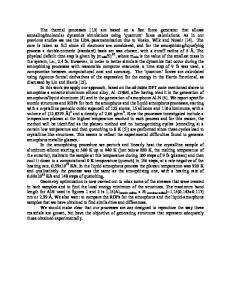Ab Initio Study of Lattice Dynamics of Dodecaborides ZrB 12 and LuB 12
- PDF / 548,374 Bytes
- 3 Pages / 612 x 792 pts (letter) Page_size
- 33 Downloads / 250 Views
b Initio Study of Lattice Dynamics of Dodecaborides ZrB12 and LuB12 N. M. Chtchelkatcheva, b, *, M. V. Magnitskayaa, c, E. S. Clementyevd, and P. A. Alekseeve aVereshchagin
Institute for High Pressure Physics, Russian Academy of Sciences, Troitsk, Moscow oblast, 108840 Russia Institute of Physics and Technology, Dolgoprudny, Moscow oblast, 141700 Russia c Lebedev Physical Institute, Russian Academy of Sciences, Moscow, 119991 Russia dKant Baltic Federal University, Kaliningrad, 236016 Russia e National Research Center “Kurchatov Institute,” Moscow, 123182 Russia *e-mail: [email protected]
bMoscow
Received June 27, 2019; revised July 27, 2019; accepted August 10, 2019
Abstract—We investigate the lattice dynamics of frame-cluster dodecaborides ZrB12 and LuB12 in the framework of the electron density functional theory. Our ab initio calculations are performed using the Quantum Espresso package, with PAW-type pseudopotentials. We compute the phonon properties, such as phonon dispersions and atom-projected densities of states. A comparison is made with a few available ab initio calculations. The results obtained are consistent with inelastic neutron scattering measurements, as well as with experimental Raman spectra. We provide a quantitative confirmation of the experimentally known mixing of the eigenvectors of boron and metal vibrations. Keywords: rear-earth borides, ab initio calculations, lattice dynamics DOI: 10.1134/S1027451020070083
INTRODUCTION Frame-cluster systems are complex compounds with a wide range of ground state types, which predetermines the functional properties and possibilities for considering them as promising materials. The lattice dynamics of such systems is not always amenable to calculations in the framework of widely known phenomenological models, which is established when comparing such model calculations with available experimental data. The reasons for this are obviously related to the nontrivial physics of interatomic interactions and electronic subsystem of these compounds. Typical examples of such systems are dodecaborides of transition and rare-earth metals. Along with the unusual physical properties of their d- and f-electron subsystems, a number of anomalies and features of the lattice dynamics [1] are observed in experimental phonon spectra. Obviously, the origin for this is the strong hierarchy of interatomic interactions and a large difference in the masses of constituents. A rigid cluster frame is formed on this basis, which is stabilized by electrons entering the conduction band from the f (or d) electron shells of a heavy metal ion. The state-of-the-art ab initio calculations of the phonon spectrum of transition metal and rare-earth dodecaborides (e.g., [2, 3]) do not always describe the density of phonon states measured in neutron experi-
ments well enough. Certain difficulties arise when trying to describe from first principles acoustic branches associated with vibrations of not only metal, but also boron ions, as well as the parameters of the energy gap between a
Data Loading...











